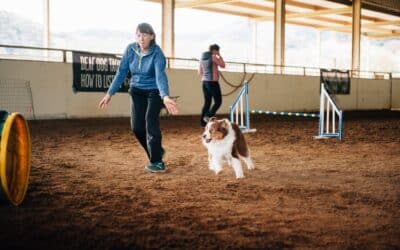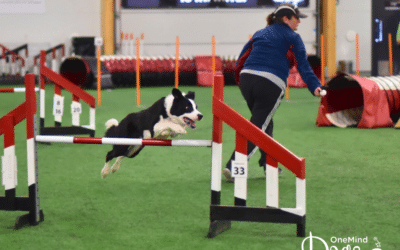When the world of thinking agility courses in lines opens up to you, you forget the handling of individual obstacles for good.
OneMind Dogs founder, Janita Leinonen, started agility in 1993. For the first ten years, all she saw in the agility ring was individual obstacles. Janita says: “I handled my dog one obstacle at a time, aiming to somehow get her through the course without elimination. Despite not knowing better, we had decent results. We managed clear rounds and all my dogs earned their Agility Champion titles. After ten years of doing agility like this, one of my dogs lost her hearing. She opened the door to a completely different world of agility. She helped me to see a way that did not focus on the obstacles. She taught me to focus on the imaginary path of the dog, the optimal path that exists in my mind.”
So what does that mean for agility?
This post is an excerpt from a full article available for OneMind Dogs premium members, written by our leading Coach and creator of the OneMind Dogs method, Janita Leinonen. The full version includes multiple illustrations, and detailed advice on how to understand the dog’ lines in agility.
Upgrade now to check it out!
Fast and safe
When the dog stays on the optimal line you are more likely to have more clear rounds. It is also the fastest way to get around the agility course. Nowadays in competitive agility every hundredth of a second counts and all extra footsteps the dog takes turn into time loss.
Perhaps the best way to describe how I see the agility course now, is to picture my dog driving a rally car, with me as the co-driver. I want to be the best possible co-driver for my dog. I want to be able to tell her all about the upcoming turn, when to accelerate, and when to decelerate before a tight turn, all at the right moment. At the agility course, I picture the ideal path for my dog to stay on from start to finish. If she is not on this line all the time, it means I have guided our car off the road.
Optimal path or agility anorexia:
You might wonder how to determine where the ideal line for the dog is. For example, where the dog needs to turn after a jump, how do you avoid expecting the dog to do something she is physically incapable of doing? From our point of view, when the dog lands facing the right direction, so that she can accelerate immediately after landing, the turn is adequate, despite how far from the jump the dog actually lands. We call the kind of thinking where the handler isn´t satisfied with any turn the dog makes, agility anorexia. The handler always expects the dog to turn so tightly that her side almost touches the wing. To achieve these types of turns, the handler needs to make the dog decelerate drastically and do a major collection on her strides before takeoff. Often, timing sequences in training can help to change the distorted image of the best path that the handler has pictured in her head. Timing can point out the differences between the image of the ideal performance, and the reality.”
The line determines the technique
As an example we have a backside jump, from where the dog is supposed to continue to five different paths.

The dog stays through the sequence from jump one to obstacle three on the handler’s left side. When you start executing the handling technique of your choice before your dog reaches the point of takeoff, you have proactively given her all the information she needs to successfully clear the jump and land on the path you want her to take next. In European courses we see a lot off-course obstacles. Often if you just let the dog jump over the bar without adjusting her line before takeoff, the dog´s natural line leads straight to an off-course obstacle. Letting the dog jump straight towards the off-course obstacle can easily cause the dog to perform it and get eliminated.
One of the benefits of mastering the different handling techniques and combinations of cues, is to be able not just do clear rounds, but to be able to do high quality clear rounds, consistently, in every type of course. You can get your dog to run exactly on, or close to, the ideal line from start to finish, consistently.
One participant in our California seminar in December 2013 said: “I have been doing agility for a long time, but after the seminar my view of it has changed forever.” When the world of thinking in lines opens up to you, you forget the handling of individual obstacles for good.
Want to check out the full article? Upgrade to Agility Premium below for access to this article and hundreds more.



